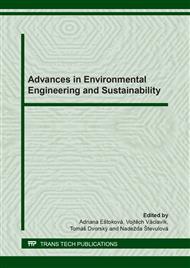[1]
P. Konrád, P. Gallo, R. Sovják, Š. Pešková, J. Valentin, The applicability of by-products in civil engineering for production of eco-bricks, Technika ochrany prostredia (2019) pp.1-6.
Google Scholar
[2]
M. Ben Mansour, A. Jelidi, A.S. Cherif, S. Ben Jabrallah, Optimizing thermal and mechanical performance of compressed earth blocks (CEB), Constr. Build. Mater. 104 (2016) 44–51.
DOI: 10.1016/j.conbuildmat.2015.12.024
Google Scholar
[3]
M. Mostafa, N. Uddin, Experimental analysis of Compressed Earth Block (CEB) with banana fibers resisting flexural and compression forces, Case Stud. Constr. Mater. 5 (2016) 53–63.
DOI: 10.1016/j.cscm.2016.07.001
Google Scholar
[4]
S.O. Sore, A. Messan, E. Prud'homme, G. Escadeillas, F. Tsobnang, Stabilization of compressed earth blocks (CEBs) by geopolymer binder based on local materials from Burkina Faso, Constr. Build. Mater. 165 (2018) 333–345.
DOI: 10.1016/j.conbuildmat.2018.01.051
Google Scholar
[5]
H. Porter, J. Blake, N. K. Dhami, A. Mukherjee, Rammed earth blocks with improved multifunctional performance, Cem. Concr. Compos. 92 (2018) 36–46.
DOI: 10.1016/j.cemconcomp.2018.04.013
Google Scholar
[6]
F.V. Riza, I.A. Rahman, Eco-Efficient Mason. Bricks Blocks, Elsevier, 2015, 379–392.
Google Scholar
[7]
G. Ruiz, X. Zhang, W. F. Edris, I. Cañas, L. Garijo, A comprehensive study of mechanical properties of compressed earth blocks, Constr. Build. Mater. 176 (2018) 566–572.
DOI: 10.1016/j.conbuildmat.2018.05.077
Google Scholar
[8]
J.D. Sitton, Y. Zeinali, W.H. Heidarian, B.A. Story, Effect of mix design on compressed earth block strength, Constr. Build. Mater. 158 (2018) 124–131.
DOI: 10.1016/j.conbuildmat.2017.10.005
Google Scholar
[9]
ASTM D2487-17, Standard Practice for Classification of Soils for Engineering Purposes (Unified Soil Classification System), ASTM International, West Conshohocken, PA, (2017).
Google Scholar
[10]
R. Sovják, Š. Pešková, V. Šmilauer, M. Mára, P. Růžička, L. Černá Vydrová, P. Konvalinka, Utilization of crumb rubber and FBC-based ternary binder in shotcrete lining, Case Stud. Constr. Mater. 11 (2019) e00234.
DOI: 10.1016/j.cscm.2019.e00234
Google Scholar
[11]
ČSN 72 2609, Method of Tests for Masonry Units - Specific Properties of Clay Masonry Units, Úřad Pro Technickou Normalizaci, Metrologii A Státní Zkušebnictví, Prague, (2017).
Google Scholar


